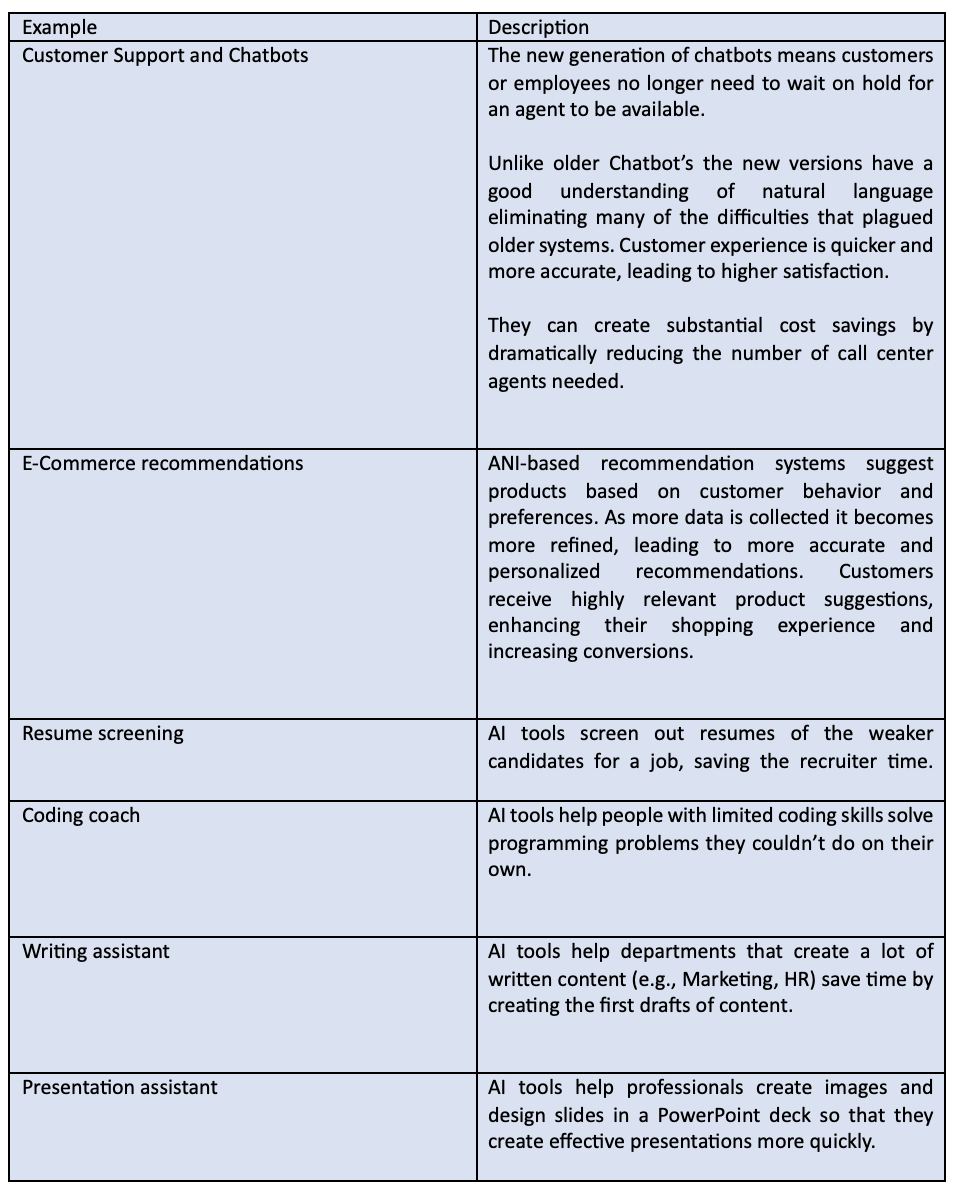How Leaders Can Leverage Artificial Intelligence (Part 2)
Note: There are so many Artificial Intelligence (AI) articles circulating at the moment on the technical side. This is different, it’s about the people side of AI, what this means for leaders in particular.
At Top Gun Ventures, one of our Partners experiences with Artificial Intelligence (AI) goes back to 1985 when he helped an Aerospace company hire a Director of Artificial Intelligence. In those days they were using AI to help with composite stealth materials research; these days it feels like AI is everywhere, helping with everything. Today, in 2023, we are working with an AI research organization to assess the leadership team’s capabilities to drive change.
We believe that ultimately success with AI will rest on leadership and how they tackle the opportunity. In part 1 of this article, we provided a primer on AI. In part 2, we share our advice on what leaders should do to best leverage AI in their business.
A FRAMEWORK FOR GUIDING ARTIFICIAL INTELLIGENCE DRIVEN CHANGE
The application of AI will ultimately lead to the positive transformation of industries and traditional business models. Given this inevitability, the best framework to look at the impact of AI is through the different levels of change leading to transformation.
Brian Solis, a well-known digital anthropologist, futurist and author, often discusses the intersection of technology, business, and human behavior and their combined impact on businesses, markets, and societies. His framework of the three different levels of change is helpful in understanding the impact that AI will have on our businesses. We have used this framework to provide an effective lens for our clients who are either disrupting the market or being disrupted by new entrants.
Levels of Change:
- Iterative: Improving something that exists; doing things better, faster, more efficiently, or at scale.
- Innovative: Doing new things that create new value.
- Disruptive: Doing new things that make the old things obsolete.
The important insight for leaders is that they need to operate simultaneously at all three levels of change.
LEADING ITERATIVE CHANGE WITH ARTIFICIAL INTELLIGENCE
AI can automate repetitive tasks, enabling employees to focus on higher-value activities that drive innovation. It can significantly enhance iterative change by gathering and analyzing vast amounts of data to identify, patterns, trends, and customer preferences.
One of the benefits of ChatGPT has been making programmers more productive. That’s an iterative change. You still have programmers, and they are still doing the same work, it’s just that they get a lot more done by virtue of having an AI assistant.
There are many opportunities to apply AI to create iterative change. OpenAI says that “approximately 80% of the U.S. workforce could have at least 10% of their work tasks affected by the introduction of GPTs, [i.e., Gen AI] while around 19% of workers may see at least 50% of their tasks impacted” (see research paper). The sum of those iterative changes could have a meaningful impact on the bottom line.
Examples of Iterative Change:
As OpenAI has indicated, AI tools can impact a very wide variety of tasks. Table 1 provides a few examples to illustrate the kind of change you can expect.
Table 1: Examples of Iterative Change
 What leaders need to do to support iterative change:
What leaders need to do to support iterative change:
A lot of iterative change can be done by individual employees. Leaders need only do a few things to enable employees to make those changes. The first is to establish simple and reasonable guidelines so that employees are clear about what they are and are not allowed to do with AI. The second is to provide educational resources. The third, and perhaps most important factor, is to encourage employees to take the time to master these new tools.
LEADING INNOVATIVE CHANGE WITH ARTIFICIAL INTELLIGENCE
AI’s ability to process and analyze complex data sets can lead to the discovery of novel insights and opportunities. It can be used to identify unmet customer needs, create personalized experiences, and even predict future trends. This leads to innovative solutions that differentiate you from the competitors.
Being a champion of iterative change is a good start for innovative change because the more familiar you and your employees are with AI the more likely you are to see bigger opportunities.
Examples of Innovative Change:
AI tools create opportunities for innovative change, however, grasping those opportunities is not an easy task. It only happens when leaders commit to supporting innovations.
Table 2: Examples of Innovative Change
Source: Draft generated by ChatGPT then edited by humans
What leaders need to do to support Innovative change:
Innovative change won’t happen without strong support from leadership. Some of the questions to ask:
- Do we have the right people to discover opportunities for innovative change? Are there bright, curious people who can think outside of the current ways of doing things?
- Do we have managers who can implement innovative change? Are there managers who are capable change leaders who can tackle the complexities of introducing innovations?
- Do we have leaders who provide all the needed support for innovative change? Do leaders provide time and resources for people to experiment?
- Are failures punished or seen as learning opportunities? Are leaders savvy to the organizational issues that act as barriers to innovative change and act to overcome them?
LEADING DISRUPTIVE CHANGE WITH ARTIFICIAL INTELLIGENCE
AI has the power to fuel disruptive change across industries. AI can lead to the transformation of traditional business models. This can result in the emergence of new players, services, and market dynamics.
Disruption driven by AI might require organizations to rethink their strategies and adapt quickly to remain competitive as was the case with Google. Google called a “Code Red” due to the disruptive impact AI could have on their search business.
Disruptive change is doing new things that make old things obsolete and that’s why the Hollywood writers and actors are worried enough about AI disrupting their industry that it’s contributed to them going on strike.
As Brian Solis reminds us, it’s also about ‘unlearning’ things we accept as standard protocol that never added value to the customer in the first place. Amazon’s Go Store is an example. No lines, no checkout – just grab and go and your mobile phone and app takes care of the rest.
Examples of Disruptive Change:
Might your organization be at risk of being disrupted? Might you have the opportunity to be the disruptor?
Table 3: Examples of Disruptive Change
Source: Draft generated by ChatGPT then edited by humans
What leaders need to do to support disruptive change:
Disruptive change, doing new things that make the old things obsolete, won’t happen without strong support from the CEO, board, and investors. This is where you start to disrupt the market to meet the emerging and future needs of your customers. Unless you have a Steve Jobs in your company the ideas for disruptive change will likely come from multiple innovations and a combination of successes with customers that point to a new business model to delight them.
WHAT KIND OF LEADERSHIP TEAM DO YOU NEED?
Your ability to seize the opportunities AI creates will rest on the abilities of your leadership team. At Top Gun Ventures, we typically deal with organizations in rapid growth, driving disruptive change, or being disrupted by new entrants. In this context, we have found it helpful to differentiate between these different types of ‘leaders of change’:
LEADING ITERATIVE CHANGE WITH AI:
- Leaders with a proven background of accelerating business growth and financial performance by getting the best out of people, processes, and technology.
LEADING INNOVATIVE CHANGE WITH AI:
- Leaders with a proven background of launching a new product, service, or capability inside an existing company that drives new growth and revenue streams and/or defends against disruptive innovation from new entrants.
LEADING DISRUPTIVE CHANGE WITH AI:
- Leaders with a proven background of transforming a company to deliver a new strategic offering, reinventing, or repositioning the business to meet future customer needs, and establishing a new path to sustain continued growth.
These are all high-performing leaders, but they are high-performing for different business needs, levels of change, and phases of growth.
When you are looking to bring in a new leader, you need to know what kind of leader you are looking for. Once you know that, it’s a matter of going on a hunt for leaders who have demonstrated success in the kind of change you are seeking to drive.
Finally, given the importance of AI, at some point, it will be prudent to gather the leadership team and do a self-assessment of your abilities. Do you have the type of executives who can lead iterative, innovative, and disruptive change to match your drivers of success and business priorities? If you need some extra skillsets, the earlier you know what’s missing the better.
TAKING ACTION
An action you can take today is to share Solis’s framework defining the three levels of change, iterative, innovative, and disruptive. Having a common framework will help ensure different members of the leadership team are not talking at cross purposes.
Once you have agreement on the framework it’s time to think about driving the highest priority changes. Remember that ideally, you want all three types of change. As Brian Solis has proven many times, a sequence of iterative improvements will lead to innovation; a combination of innovative moves will lead to disruption.
As a starting point, use Table 4 below which shows Solis’s three levels of change and our list of six crucial drivers of business success. For each driver of success ask yourself which level of change is needed to meet our business objectives and that’s where to start making your AI investments and determining the type of ‘leader of change’ to assign to that task.
Table 4: What Changes Does Your Organization Most Need to Have Success in The World of Artificial Intelligence (AI)?
*Source: Brian Solis… https://www.briansolis.com/
IN SUMMARY
We hope this is helpful. AI is having a huge range of effects, some big some small. It is expected to drive a surge in economic growth. Leaders who make a point of taking action to enable their organization to make clever use of AI will find they’ve grabbed a competitive advantage.
In the rapidly evolving landscape of AI, organizations and leaders need to embrace a growth mindset. This involves staying curious, learning about new AI developments, and being open to experimenting with AI technologies to drive positive change and delight customers.
As Reid Hoffman, the founding investor in OpenAI/ChatGPT says “AI has a major role in benefiting humankind. As an investor, but also as a humanist, I want my participation in anything AI to support that goal of elevating humanity.” As leaders, this is a good thought for us to keep in the back of our minds as we introduce the power of AI to our organizations.
Artificial Intelligence (AI) is already disrupting existing industries and creating new markets and this will demand a new set of leadership archetypes. If you have an interest to explore further, let’s chat.
Back to Insights



